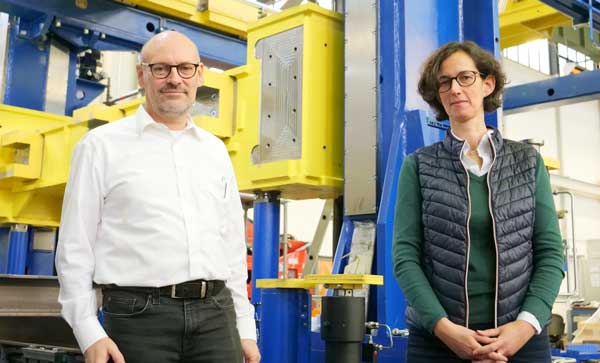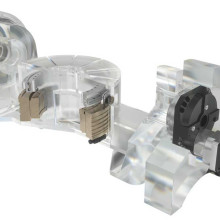Profile rail guide using modern foundry technology from Laempe
- Details
- Hits: 4973
The LHL300-1700 core shooter is characterized by short cycle times, robustness and finesse Laempe Mössner Sinto GmbH. The built-in components ensure robustness Profile rail guides from Schaeffler. You can even under adverse conditions like in the Foundry technology Hold a maximum load of 300 tons.

Contents
- Core making from manual work to automation
- Robust linear technology in core shooting machines
- Profile rail guides can support 300 tons
- Encapsulated or open-running guides
- Durasense adapts to tribological requirements
- FAQ
Core making from manual work to automation
The core making shop and the foundry were until the 20th century characterized by hard manual work. For several decades, modern systems have been established worldwide Robotic and Control Technology partially and fully automated core making shops, including in particular core shooting machines. The company Laempe Mössner Sinto has specialized in the development of these machines and the complete automation of the core making shop. The individual process steps consist of sand preparation, core production, core transport and core processing.
The engineers at Laempe design the systems for their global customer base individually according to customer specifications. For example, you determine the core size, the shot volume and the cycle time. They also implement solutions that go far beyond previous limits. The LHL300-1700 core shooting machine presented here is impressive with its shot volume of 1700 liters - a world record.
Robust linear technology in core shooting machines
 The production of cores is almost as old as that metal casting itself and the principle hasn't changed much. For centuries, core sand has been mixed with binding agents, pressed into a mold consisting of a two-part box and hardened.
The production of cores is almost as old as that metal casting itself and the principle hasn't changed much. For centuries, core sand has been mixed with binding agents, pressed into a mold consisting of a two-part box and hardened.
Today there are two methods for hardening the molding sand:
- The Cold box-Process: Hot gas is blown through the molding sand.
- The Hot box-Process: Here the mold itself is heated and the sand is “baked”.
At the core shooting machine LHL300-1700 are used to remove the core from the upper box Hydraulic cylindern raised and the lower box moved outwards over a transverse axis. After the core has been removed, the lower core box moves back under the upper box.
This is followed by the so-called shot. This completes the filling of the closed core box molding sand meant. Due to the large core box area, the core box halves have to be pressed together with 300 tons.
Eight leading cars recirculating roller guides RUE from Schaeffler cause the core lower box to move back and forth. So that they do not have to bear the high pressing force, they are mechanically decoupled from the core box before each shot: a device lifts the core box off the carriage and locks it on supports. The guide carriages are loaded by the dead weight of the core box including the core, which is around 30 tons.
Profile rail guides can support 300 tons
 “When designing the profile rail guides, product manager Philippe Gasser nevertheless decided to take the high load of 300 tons into account,” explains Frank Niemeyer, project manager at Laempe.
“When designing the profile rail guides, product manager Philippe Gasser nevertheless decided to take the high load of 300 tons into account,” explains Frank Niemeyer, project manager at Laempe.
“Should there be a defect in the control or mechanics and the core box rests directly on the guide carriage when shot, the guide carriages and the substructure must still be able to withstand this overload of 300 tons.”
Alexandra Short, an application engineer from Schaeffler, adds: “For the nominal load of 30 tons, size 65 roller circulation units would have been completely sufficient. Size 100 fits the limit load of 300 tons - a rather rare case - with sufficient safety.
Guide carriage not always crucial
The decision for the Size 100 In practice, this does not always depend on the load capacity of the guide carriage,” reports the engineer. “It is often a matter of appropriate introduction and distribution of forces into the surrounding structure, sometimes also of unknown shock loads.”
The linear guides and their rolling elements were designed for one three-year lifespan designed. After that, major maintenance is required. Because the molding sand causes enormous wear on all moving components of the machine, the guides are replaced after this period.
Encapsulated or open-running guides

The abrasive molding sand ensures a heavy contamination of these machines. This raises the question of whether the moving and lubricated components should be encapsulated. Frank Niemeyer answers: “There is a good reason why we do not use any encapsulations on the entire machine, not even on the profile rail guides.
Damaged or leaking encapsulations remain undetected in automated machines for a long time. The molding sand that then penetrates is chambered and constantly moved back and forth by the scrapers. An open guide system with a high-quality scraper has proven to be more reliable proven.”
Low lubrication thanks to condition monitoring
 “All moving components are included as little lubricant as possiblef supplied,” says the project manager. “The smaller the amount of lubricant that adheres to the surfaces, the less molding sand sticks and the less sticks to the surfaces. For these reasons, when it comes to maintenance intervals and, if necessary, condition monitoring, we concentrate on all components that are moved.”
“All moving components are included as little lubricant as possiblef supplied,” says the project manager. “The smaller the amount of lubricant that adheres to the surfaces, the less molding sand sticks and the less sticks to the surfaces. For these reasons, when it comes to maintenance intervals and, if necessary, condition monitoring, we concentrate on all components that are moved.”
Optimized sealing concept
Alexandra Kurz about choosing the reel circumference RUE100-EL in this machine: “Under these harsh conditions, we recommended an optimized sealing concept with low-wear wipers made of NBR. These are already being used successfully in other core shooting machines from Laempe and have proven themselves very well.”
Laempe lubricates the profile rail guides over the central lubrication system already at the lowest limit that makes sense for this application. According to Ms. Kurz, this is an opportunity to further reduce lubricant consumption: “With an as-needed relubrication of the guide carriages, lubricant consumption could be reduced even further without having to accept any loss in the service life of our linear systems.”
Durasense adapts to tribological requirements

With Durasense Schaeffler already offers a suitable system solution for profile rail guides. The Durasense system monitors using integrated sensors the lubrication condition and only initiates relubrication if this is actually necessary from a tribological point of view.
Lubricant consumption can be reduced by up to Reduce 30%. And if sand particles do get into the guide carriages, the sensors will detect this. This is an interesting perspective because, according to Frank Niemeyer, regular cleaning of machines is often neglected in this industry.
FAQ
What do foundries do?
In industrial foundries, metal raw materials - typically iron, steel, aluminum, copper and zinc - are liquefied by heating them to the melting point and then poured into prepared molds. Become like this precise Metalcomponents manufactured. The manufacturing processes in foundries are ideal for casting large quantities with consistent quality.
What kind of casting processes are there?
The foundry industry uses various casting process such as sand casting, die casting, investment casting, chill casting, centrifugal casting, continuous casting or full mold casting to meet the specific requirements for product properties such as number of pieces, materials, size, shape, strength and Surfacesto meet the requirements.
What is a core making shop?
A core factory is an area within a foundry industry where sand cores are manufactured. These cores are placed in molds to create cavities or complex internal geometries in cast workpieces. Production usually takes place by compacting core sand around core boxes or by shooting sand into core molding machines. After the metal has solidified, the sand cores are removed and the inner contour of the casting is exposed.
What is a profile rail guide?
A profile rail guide is a precise linear guide system that consists of a guide rail and one or more carriages. The Linear rail has a specially shaped raceway profile in which the carriages slide with little friction on rolling elements such as balls or roller elements. It is used for linear movements in machines and systems in order to achieve precise and stable guidance of the components.
You might also be interested in...

Artificial Intelligence | trends and developments

Planetary gear + strain wave gear precision from Schaeffler

spindle bearing | The Vacrodur high-performance elements

Additive manufacturing on multi-material 3D printers

3D printer metal | Amazing Possibilities

Schaeffler | News from the patent forge

Jochen Krismeyer is a specialist journalist for drive and automation technology in Nuremberg.
